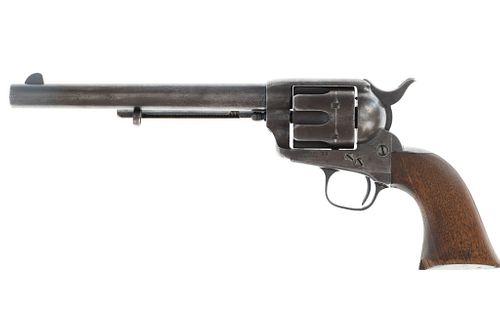This is quite possibly one of the most important Battle of the Little Bighorn firearms ever offered for public sale, a Colt U.S. Cavalry issue Single Action Army revolver owned personally by Boston Custer, youngest brother to George Armstrong Custer, and later owned by Chief Buffalo Hump of the Sans Arc Sioux with complete ownership history and documentation.
Under General Terry’s Special-Order Number 117 on June 8, 1874, Colonel Custer acted to prepare his troops for the extended 1874 Black Hills Expedition, obtaining suitable arms for certain non-regular army personnel. Shipment information to Custer at Fort Lincoln, as obtained from jobbers used by the Colt Company, Schuler, Hartley & Graham of New York an H&D Folson, also of New York noted the shipment of six nickel plated revolvers shipped on July 29, 1874 from H&D Folson: Serial numbers 7486, 9977, 12057, 12443, 12937; and 13418 and a shipment from Schuyler, Hartley & Graham included: Serial numbers 10960, 11258, 11722, 11843, 13221, and this revolver, 12364. The nickel revolvers are all documented to 7th Cavalry Indian scouts (see Table 7, beginning at page 148 of the book, Documenting the Weapons Used at the Little Bighorn). The blue finished revolvers are documented, also on Table 7 starting at page 148 identifying serial number 11722 issued to Dr. Porter, 11843 to Dr. Lord, 10960 went to Moses Milner a civilian scout and 12364, the firearm in this lot, issued to Boston Custer who was acting as a packer in the pack train.
It is noted by documented testimony from Oglala Sioux Horned Horse that on June 25, 1876 at the Battle of the Little Bighorn Horned Horse and Buffalo Hump went together crossing the Greasy Grass River at the ford. They rode to a high point to watch the battle, as Horned Horse was an old man tired of battle. They saw a lone soldier wearing buckskin clothing crossing in front of them to the north, riding a mule that was carrying some bags. Buffalo Hump told Horned Horse he wanted the mule and Horned Horse replied, “Han napiyuza sonsonla (Yes! Capture Mule)”. It should be noted for confirming this story that Captain Frederick W. Benteen, the Company H Commander of the 7th Cavalry gave testimony about Boston Custer, “He was with the pack train, the morning of the 25th, but when Boston overheard trumpeter John Martin’s message from George Custer to me to “…come on and be quick and bring packs,” Boston mounted one of the mules carrying ammunition and rode north.” Also noted 1st Lieutenant Edward S. Godfrey Commander of Company K said this about the Custer brothers, “The Custers wore buckskin suits…”
Later Horned Horse and Buffalo Hump were at the spotted of the buckskin wearing man with mule, both found dead. Buffalo Hump took the boots and the revolver from the buckskin wearing young soldier (is clothes being taken by another). As per the body location as noted by 1st Sergeant John M. Ryan, Company M of the 7th Cavalry and Captain Benteen were both on burial crew and stated, “On the battlefield 200 feet down the hill from Last Stand Hill were General George Custer and his brother Tom Custer were killed, lay the bodies of their brother Boston and 18-year-old nephew Harry Armstrong “Autie” Reed. Boston was stripped expect for his stockings.”
After the Little Bighorn, Buffalo Hump and Horned Horse rode with Crazy Horse at the Battle of Wolf Mountain against General Miles and the 5th Cavalry. Horned Horse surrendered with Crazy Horse on May 5, 1877 at Fort Robinson to 1st Lieutenant William P. Clark and Horned Horse acted as Crazy Horses interpreter. When Crazy Horse was killed on September 5, 1877, both Buffalo Hump and Horned Horse were present and heard Crazy Horse say on his deathbed, “I have always wanted to go to the land of the Grandmother (Canada). I shall be dead in a few minutes and will then go to the Grandmother’s country. I want you to all follow me”. In spring 1878, Buffalo Hump and some 240 lodges of the Crazy Horse band made their way into Canada including Little Hawk, the Black Elks, Low Dog and Black Fox heading for Sitting Bull’s camp. After arriving at Sitting Bull’s camp, some of their horses were stolen by a local tribe. Nicholas Black Elk and his uncle Running Horse were present on the day of the Buffalo Hump incident and their story was documented, “I was only 15… Our camp had lost some horses during the night. One of the horses belonged to Chief Buffalo Hump. Sitting Bull sent for the Grandmother police, as he was told to do by “Paddy” (Supt. James Morrow Walsh from the North West Mounted Police NWMP). Paddy sent “Big Bull” (Assistant Commissioner Acheson G. Irvine of the NWMP) and two policemen to settle the matter. As Big Bull (Irvine) rode int the camp, Buffalo Hump rant up to him to tell him about his stolen horse.. carrying his revolver in one hand and a knife in the other. Big Bull (Irvine) grabbed the revolver out of Buffalo Hump’s hand… Sitting Bull walked up behind… and said “Austan” (cease, finish, stop) Big Bull (Irvine) found the horses and returned them to Buffalo Bull, but he did not return the revolver. Day later Buffalo Hump asked Big Bull (Irvine) if he could have his gun back, but Big Bull (Irvine) said he had given it to the Commissioner of the NWMP, James Furguharson MacLeod as “Evidence””
Buffalo Hump and his Sans Arc band left Canada and surrendered at Fort Keogh and was transferred in August 1881 to the Spotted Tail Agency in Nebraska.
Commissioner MacLeod served from July 22, 1876, to October 31, 1880, and oversaw the moving of police headquarters to Fort MacLeod being accredited with establishing peaceful policies for the NWMP in dealings with First Nations people. It is almost certain that Commissioner MacLeod held the Buffalo Hump Colt at this location. The gun stayed in the NWMP, later changing their name to the Royal Canadian Mounted Police RCMP, possession from 1878 until around 1922. In around 1920 William Northcote Taylor joined the RCMP, son of famed Indian Agent in the Northwest Territories William Richard Taylor the agent with whom Dr. Claude Lewis and his brother, Sinclair Lewis made a trip by canoe to make treaty payments to Northwest First Nations tribes memorialized in the book “Treaty Trip” in 1924.
As per the testimony of William N. Taylors daughter, Karen Taylor in the accompanied signed letter, her father won the Colt Revolver serial number 12364 in a poker game while stationed at Fort MacLeod in Alberta, Canada in 1922. The gun then stayed in the Taylor family from 1922 until 1990. William N. Taylor dutifully registered the gun, per Canadian Law until his death in 1979 when ownership fell to his daughter Karen Taylor (an accompanying original Canadian Firearm Registration Certificate from 1945 filled out by William N. Taylor is with the lot). Karen Taylor sold the gun to a Canadian arms collector Vernon Vossler in 1990. It was published in the 1991, “Colt Peacemaker Encyclopedia Volume 2” by Keith Cochran on page 343 as S/N “12,364 7 ½ .45, Cavalry Model, this revolver was probably taken from a Sioux warrior in Canada after the battle of the Little Bighorn by an Indian Agent and Judge and then passed to his sone who was a Mountie or member of the Northwest Mounted Police. (See page 344).” The gun was in the Vossler estate from 1990 until 2008 when It was sold again in his estate sale by Bud Haynes Auction of Red Deer, Alberta (an original printout of the sale bill noting the gun, then further confirmed by Hayes, is included). At the sale the gun was purchased by Barry Kolbert, a collector from Red Lodge, Montana, only 125 miles away from the Little Bighorn. Kolbert then traded the gun to Wallace W. Francis who then traded the gun (with accompanying signed letter) to the current owner J. Michael Peters in 2016 (trading away a Colt Baby Burgess SN 6209 with letter, Colt SAA SN 962, Colt SAA SN 18318 and an additional $1,000 for this Colt SN 12364).
In addition to the testimony and ownership documentation the firearm was examined by Wendell Grangaard of the Guns of History and found to be a correct matching serial number U.S. Cavalry issue Colt Single Action Army included on the Schuler, Hartley & Graham list. The gun has the legible cartouche of O.W. Ainsworth and the correct “A” inspector mark of Ainsworth, as well as the usual filings of the muzzle often used as a mark of Indian ownership by the Sioux. Most importantly the gun was found to be marked on the butte of the frame and grips by Chief Buffalo Hump telling the story of the gun in togia language. Marked on the bottom, “kill two non-soldiers – Greasy Grass – Buffalo Hump rode with Horned Horse – departed travel long rode Grandmother Land.” This further confirms the above documentation.
Provenance: From General Terry’s Special-Order Number 117 issued to Boston Custer from a shipment from Schuyler, Hartley & Graham. Taken by Boston Custer to the Battle of the Little Bighorn where he was killed. Taken by Buffalo Hump and Horned Horse and eventually taken into Canada to Sitting Bull’s Camp in spring 1878. Seized by Canadian North West Mounted Police Assistant Commissioner Acheson G. Irvin as “evidence” and transferred to NWMP Commissioner, James Furguharson MacLeod. Won in a poker game at Fort MacLeod by RCMP William Northcote Taylor in 1922. Kept in the Taylor family from 1922-1990. Sold to Vernon Vossler in 1990. Vossler collection from 1990-2008. Sold in Bud Haynes Auction in August, 23, 2008, to Barry Kolbert of Red Lodge, Montana. Sold / Traded to Wallace W, Francis. Kolbert, Francis 2008-2016. Traded to J. Michael Peters 2016-present.
Publications: 1991 Colt Peacemaker Encyclopedia Volume 2 by Keith Cochran; Document the Weapons Used at the Little Bighorn by Wendell Grangaard; and in Alberta Genealogical Society Relatively Speaking Volume 44, Number 3 August 2016 page 141-146 (booklet or print outs of pages mentioned included as documents).
This historic piece includes a completely ownership history from its shipment to Custer’s men, capture by the Indians at Little Bighorn, capture by the NWMP in 1878, to the Canadian ownership in 1922 to present day. The ownership history has been published in the included book. Further the gun includes a historic analysis and documented testimony from Guns of History’s Wendell Grangaard as well as further documentation and signed letters. Possibly one of, if not the most well researched and recorded Battle of the Little Bighorn firearm ever brought to public sale.
Antique Colt Model 1873 Single Action Army with correct U.S. stamping, “PAT. SEPT. 19, 1871, PAT. JULY, 2, 1872” on the side; matching 12364 serial number on the bottom of the butte frame, frame, trigger guard and 2364 on the cylinder. Inspection “A” mark on trigger guard, “A” and “P” on bottom of barrel, “P” and “A” on cylinder and “609” on swing out loading door. Top of the gun is marked in a single line, “COLT’S PT. F. A. MFG. Co. HARTFORD, CT. U.S.A.” cross like stamp before and after the address. The gun retains some of the original blue finish and is well kept, has the correct four click hammer pull back which turns the cylinder and correctly functions.
















































